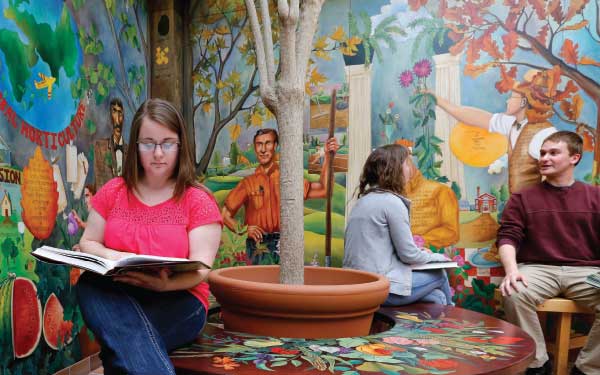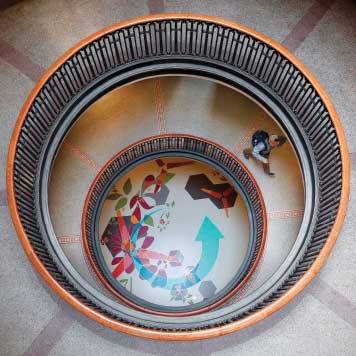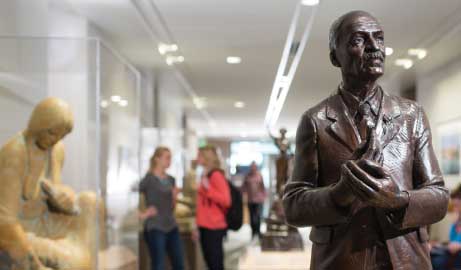
Telling Agriculture’s Story with Color, Light, Emotion
Fragments of glass, layers of plaster, mounds of oil paint on canvas, grooves burnt into wood – these are not what many consider tools of the trade in agriculture and life sciences. But, in the hands of some of the nation’s finest artists they transform ordinary materials into extraordinary and compelling works of art illustrating Iowa’s agricultural heritage and future possibilities.
Thanks to Iowa’s Art in State Buildings program, the university recently added several such pieces to the ISU Art on Campus. The program requires one half of one percent of the state’s portion of total construction costs for new and renovated state buildings to be used for public works of art. Additionally, the support of Iowa State friends and alumni have provided for several new agriculture and life sciences related pieces.
Floating World
The Biorenewables Complex, which includes the new Sukup Hall and Elings Hall, features Floating World by artist Ralph Helmick (shown on the cover). Suspended in the Sukup Atrium, the sculpture consists of 14 painted steel scrim panels that weigh around 3,000 pounds. Light infuses and reflects off the surfaces, creating endless variations of light throughout the day and with the change of seasons. The sculpture embodies the university’s central role in the history of agriculture, while subtly reflecting ISU’s groundbreaking contemporary endeavors. The panels start with an early family farmstead and ascend to a modern large-scale agricultural operation.
ISU Horticulture…looking back, looking ahead…cultivating knowledge now
In the fall of 2011, ISU honorary alum Sarah Grant, principal artist and founder of Sticks, Inc. took up residency in the atrium of Horticulture Hall. There she designed several mural panels which she took to her Des Moines studio to burn, paint and seal before installation. The artwork illustrates the history of the department and its faculty beginning in 1866. It exemplifies Iowa beauty in every season from the ripe green of watermelon to the burnt red and orange colors of fall.
All the Way Home

All the Way Home, 2013 Julie Chang (American, b. 1979) Site integrated terrazzo floor with brass and bronze insets. Commissioned by University Museums and the College of Agriculture and Life Sciences. Iowa Art in State Buildings Project for Curtiss Hall. In the Art on Campus Collection, University Museums, Iowa State University. Located in Curtiss Hall rotunda.
Colored stone and glass integrated with brass and bronze insets provide a colorful foundation for the ground-floor rotunda of Curtiss Hall in All the Way Home by Julie Chang. Using epoxy terrazzo, Chang portrays aspects of agriculture that include a flowering soybean, wind energy, brass weevils and bronze cow hoofprints. Overlapped with a strong circular arrow, the interconnectivity of agriculture is emphasized.
A Sustained Legacy: Advancing Science, Students, Farms, the World
Created with tens of thousands of pieces of stained glass by ISU alum Clint Hansen, A Sustained Legacy: Advancing Science, Students, Farms, the World was installed in May. Hansen spent more than a year working on the mural, incorporating suggestions of animal scientists. Funded by ISU alumni Rich and Nancy Degner and the Art in Public State Buildings program, the piece was commissioned to be a timeless representation of agriculture and technology. The 40-foot-by-6-foot work features youth caring for and showing livestock and includes former department chair Maynard Hogberg. (See page 36 to learn more about the mural and about Rich and Nancy Degner.)
Dean’s Gallery
 The Dean’s Gallery in Curtiss Hall celebrates the rich history of agriculture and life sciences at Iowa State. Opened in 2012, the gallery transformed the entrance to the dean’s office suite from a cluttered corridor to a warm gathering space welcoming visitors and students.
The Dean’s Gallery in Curtiss Hall celebrates the rich history of agriculture and life sciences at Iowa State. Opened in 2012, the gallery transformed the entrance to the dean’s office suite from a cluttered corridor to a warm gathering space welcoming visitors and students.
George Washington Carver, a sculpture by Christian Petersen, welcomes visitors to the gallery. Other Petersen works featured include casts of the well-known Fountain of the Four Seasons and 4-H Calf. Historic judging trophies provide links to the college’s past and paintings by Iowa artist Ellen Wagener line the walls. Wagener’s work in pastel relays the drama of Iowa weather in all four seasons, including the formidable Cyclone.
Honoring a “Magic Connection”
A work of art gifted by Iowa State alumni Jim and Marcia Borel is the newest centerpiece of the Dean’s Gallery. Do you Know What’s Inside This Flower? George Washington Carver Mentors a Young Henry A. Wallace, is featured as a poster on the following pages. Jim (’78 agricultural business) is the executive vice president of DuPont and a member of the company’s Office of the Chief Executive.
“We are art lovers. We are Iowa children. We love Iowa State. Jim’s career has been in agriculture around the world. Both of our families are multigenerational farmers, or involved somehow in agriculture,” says Marcia. “This gift is meant to honor the magic of that connection between teacher and student, academia and application, discovery and development, seeds and growth – and potential. All wrapped up in it is the love for our fathers, and all farmers, whose lives’ work feeds the world.”
Dean Wendy Wintersteen says she hopes the painting inspires faculty, staff and students to reflect on how Henry A. Wallace’s family welcomed George Washington Carver to Iowa State and into their home.
“I hope they will see the value of sharing ideas, accepting diversity, mentoring students and building friendships based on mutual goals and interests,” says Wintersteen. “The amazing legacy of Carver and Wallace show the extraordinary potential of this college to help the students, the state and the world become a better place.”
The Borels agree the painting represents the important role of mentors and achievement made possible through education.
“This painting opened my eyes to the story of these two extraordinary people,” says Marcia. “One was a young man, one a child, when their paths crossed at Iowa State University. One born to slave parents, one a son of privilege. Both were loners with a curiosity about nature. It is a story about learning—on many levels. It is a story about a teacher, and a little tag-along student, and how the light of education can transcend all and lift the world to a better place. I am so proud of Iowa State for not just ‘allowing’ George Washington Carver to enroll here in that day and time, but to champion him when the biases of the day reared. You can see just how far that light of knowledge rippled through the mind of his young student, Henry Wallace, into a world fed by the science and the miracles and mysteries of the nature they both loved.”



